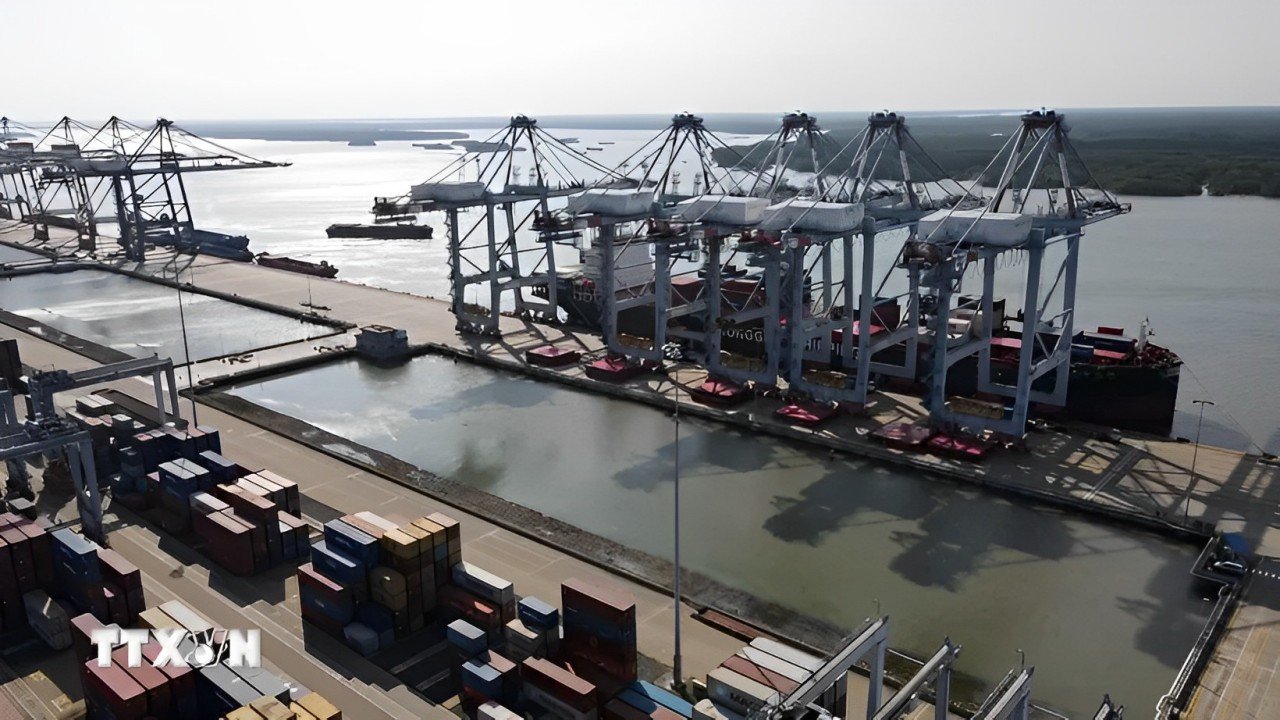Obstacles in customs mechanisms and policies will make it difficult to realize the goal of Cai Mep port becoming an international transit port, risking a great waste of the country's investment resources.
Cai Mep seaport cluster (Ba Ria-Vung Tau province) has affirmed its role in the global maritime transport chain and has a particularly important position in the socio-economic development of the entire Southern region.
However, obstacles in customs mechanisms and policies are hindering the development of this seaport area.
Stuck with "separate border gates"
The Master Plan for the Development of Vietnam's Seaport System for the 2021-2030 Period, with a Vision to 2050, was approved by the Prime Minister in Decision No. 1579/QD-TTg dated September 22, 2021, and adjusted and supplemented in Decision No. 442/QD-TTg dated May 22, 2024. Ba Ria-Vung Tau is a special-class seaport; in which Cai Mep port area (currently has 5 container terminals with a total wharf length of 3,490 m; designed capacity of 6.53 million TEU/year) is the largest international gateway and transit port system in Vietnam.
The central government, localities and enterprises have joined hands to implement many solutions to improve the efficiency of management, investment and exploitation of Cai Mep-Thi Vai port cluster such as investing in building a traffic infrastructure system connecting roads, upgrading and renovating maritime routes, applying policies to reduce maritime fees and charges, stabilizing prices of loading and unloading services, etc., especially solutions on reforming administrative procedures, public services, piloting port linkages and exploitation linkages to increase the capacity to receive ships and increase exploitation output.
In early June 2024, Cai Mep port cluster was ranked 7th (based on the calculation for 5 ship sizes) and 8th (based on the technical calculation) in terms of container port performance index - CPPI out of 405 global container ports by the World Bank and S&P Global Market Intelligence.
This is a clear demonstration of the progress of Cai Mep port in its efforts to improve its competitiveness.
The volume of import, export and transit goods through Cai Mep port has continuously increased over the years, creating attraction and encouraging foreign shipping lines to open more mother ship routes to this port.
The number of long-distance container mother ships has increased from 20 routes/week in 2016 to 37 routes/week in 2024; in which, the fleet with the largest tonnage is still periodically loading cargo at Cai Mep port every month.
Despite achieving positive results in investment and exploitation, Cai Mep port area still has many significant obstacles for shipping lines and cargo owners, hindering the formation of a solid "goods base" at this port area, especially problems related to customs mechanisms and policies.
Specifically, the Master Plan for the Development of Vietnam’s Seaport System shows a “Cai Mep Port Area” common to all ports in the cluster, but Vietnam’s customs law stipulates that each port (of a port business) is a border gate. Therefore, although in the same Cai Mep port area, each port in this area is a “separate border gate.”
.jpg)
A mother ship handling cargo at Cai Mep port will have many containers transported to and from different countries or transported domestically from the port system and inland waterways.
However, due to the above-mentioned “separate border gate” regulation, container goods moving between ports in Cai Mep port area must carry out the procedure of reopening the “Independent Transport Declaration” with many “information fields” (although this information has been declared previously and with the same Cai Mep Customs Branch – the general management agency for the entire Cai Mep port area).
At the same time, containers transferred from port to port must be re-sealed with lead seals, even though each container has been sealed with lead seals by the shipping line. These steps waste time and effort for logistics service businesses, incur additional costs for cargo owners, and even customs agencies must allocate additional personnel to perform the task.
In addition, according to port operators in Cai Mep port area, the situation of container ships needing to change ports of call is increasing due to the rapid growth in cargo volume through the port but the wharf is not ready due to many reasons.
According to current regulations, before a ship enters a port, information on all cargo must be specifically declared on the "Cargo Manifest" and if the ship wants to change to another port, it must complete the declaration and adjust the information on the "Cargo Manifest" before changing ports.
It will take a long time to complete the declaration of information adjustment for all actual goods.
With the number of ships entering Cai Mep port area increasing sharply in the coming time, shipping lines need to be facilitated and flexible for ships to change ports to proactively dock at other ports, carry out the following information adjustment procedures (completed before taking goods out of Cai Mep port cluster), without wasting waiting time, improving the operational efficiency of the entire port area.
Through research and study by Ba Ria-Vung Tau province at seaports with large international transit rates in the world such as Singapore (with an international transit rate of up to 85%), goods are transported back and forth between Pasir Panjang port and Tuas port, which are more than 25km apart, without having to reopen an independent shipping declaration or re-seal the lead seal.

Similar favorable monitoring mechanisms are also applied at Busan New Port (7 terminals with 7 operators, international transshipment rate of 77%) and Hong Kong (China) with 9 terminals with 5 operators, international transshipment rate of 70%.
Even in Hong Kong, ports have formed a Container Terminal Operators Alliance to jointly support inter-port transportation costs for shipping lines and are also allowed by the management agency to proactively support each other in arranging to receive ships when a berth has problems.
Director of the Department of Transport of Ba Ria-Vung Tau province Tran Thuong Chi said that at Cai Mep port area, the customs authority currently has a special mechanism on customs procedures for goods transferred from port to port for some adjacent ports that have opened exploitation linkage barriers such as TCIT and CMIT ports, but there is still a need for an open regulation to apply generally to other ports in the same port area, as well as across the country to attract international transit goods.
Chairman of the Board of Members of TCIT Port Truong Tan Loc hopes that Ba Ria-Vung Tau province and the Government will implement solutions to connect ports in Cai Mep port area smoothly, not only in terms of connecting information and goods but also in terms of connecting procedures and documents for releasing ships and goods similar to the model of seaports around the world.
According to Nguyen Truong Giang, Director of the Ba Ria-Vung Tau Customs Department, the unit has worked with businesses and is aware of the above obstacles. However, due to the planning history, Cai Mep port area is interspersed with ports with other functions, so it is very difficult to connect the ports.
The Ministry of Finance and the General Department of Customs have also drafted a circular regulating customs supervision of goods passing through Cai Mep port to remove the above obstacles, but due to mechanism problems, it has not been able to be issued yet.
To fix this, the unit is proposing to temporarily not stamp seals on port-to-port cargo containers that already have shipping line seals and reduce the declaration information for port-to-port cargo containers.
The problem of creating "foot goods"
According to statistics from Ba Ria-Vung Tau Provincial Customs, as of November 15, 2024, the volume of cargo containers through Cai Mep port reached 1,921,661 containers (excluding empty containers); of which, transit cargo was 84,271 containers, accounting for nearly 4.4% and if including transit cargo, it was nearly 12.4%.
Similarly, in 2023, the above rates are just over 0.3% (5,127 containers) and over 3% (as of November 15, 2023, the total cargo throughput through the port is 1,524,136 containers).
This is a fairly low rate compared to an international transit port that has been in operation for many years and shows that Cai Mep port is not really attractive for shipping lines to choose as a transit center for goods in the region.
In fact, for shipping lines and cargo owners when choosing a port of destination for their ships and goods, fast customs clearance to reduce time and logistics costs are important criteria. However, the above situation is causing significant obstacles to creating many "goods legs" for this port area.
Vice Chairman of the People's Committee of Ba Ria-Vung Tau province Le Ngoc Khanh commented that the above obstacles have partly caused logistics enterprises in the province to remain small, difficult to develop and not interested in investing and merging to increase scale and competitiveness despite the advantages of seaports and the large volume of goods circulating through the port.
.jpg) Currently, the Ministry of Transport is presiding over and coordinating with the People's Committee of Ba Ria-Vung Tau province and related ministries and branches to research and plan in detail the Cai Mep Ha port and Cai Mep Ha downstream in the Cai Mep wharf area.
Currently, the Ministry of Transport is presiding over and coordinating with the People's Committee of Ba Ria-Vung Tau province and related ministries and branches to research and plan in detail the Cai Mep Ha port and Cai Mep Ha downstream in the Cai Mep wharf area.
It is expected that after completion, the two ports will have a total wharf length of 17.9 km and a barge wharf of 1.7 km, with a total capacity of 36.8 million TEUs/year.
In addition, the Can Gio international container port project (right opposite Cai Mep port area) is in the pre-feasibility study phase with a wharf length of 7km and a barge wharf of 2km, with a designed capacity of about 16.9 million TEUs/year.
In the future, Cai Mep area will become a seaport with very large capacity. However, with the above obstacles in customs mechanisms and policies, the goal of Cai Mep port becoming an international transit port will be difficult to realize, with the risk of wasting a large amount of the country's investment resources.
Vice Chairman of the Provincial People's Committee Le Ngoc Khanh added that the Ministry of Finance and the General Department of Customs are currently drafting adjustments to decrees and circulars related to customs supervision in the direction of facilitating the movement of goods between ports and ships transferring ports within the same customs management area.
At the same time, develop a plan to apply science and technology to improve the effectiveness of management supervision towards implementing an open port mechanism at the Cai Mep container port cluster.
The implementation of the open port will also be a stepping stone and an important mechanism and policy towards the formation of a free trade zone associated with Cai Mep seaport according to Resolution No. 24-NQ/TW dated October 7, 2022 of the Politburo on socio-economic development and ensuring national defense and security in the Southeast region to 2030, with a vision to 2050./.











